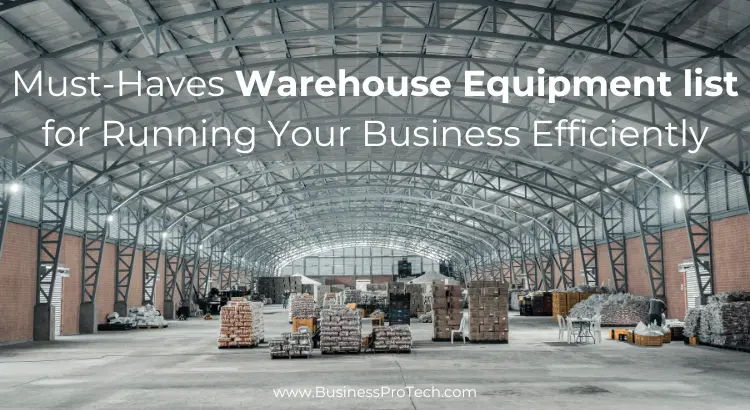Are you ready to kick-start your own warehouse business? The right setup ensures everything runs like clockwork from day one. But before you dive in, there’s much to consider beyond space and location.
Think about the last time you received a package. Every item, from electronics to groceries, has passed through multiple warehouses before arriving at your doorstep.
This behind-the-scenes journey relies heavily on well-chosen equipment to ensure everything runs like clockwork. If you are stepping into the warehouse business arena, knowing which tools and machinery to invest in will streamline operations and enhance safety and efficiency.
So, let’s dig into the must-have equipment to help you set up and run a warehouse.
Get Familiar with Your Needs
Before you start purchasing equipment, it’s crucial to understand the nature of your warehouse operations. Will you be focusing on bulk storage, eCommerce fulfillment, or cross-docking services? This understanding will guide your equipment choices, helping you avoid unnecessary expenses and make informed decisions that will benefit your business in the long run.
Essential Warehouse Equipment Checklist

To kick-start your warehouse business, here’s a list of the essential equipment you should consider:
Pallet Racks and Shelving
Pallet Racks: These are indispensable for maximizing storage capacity and organizing products efficiently. Choose from selective, drive-in, push-back, and pallet flow racks based on your specific storage needs.
Shelving Units: Shelving units provide easy access and organization for smaller items or less bulky inventory. Consider adjustable and modular units for flexibility.
Material Handling Equipment
Forklifts: A forklift is vital for moving heavy and large items quickly. Depending on your warehouse size and the weight of the items you’ll store, select from models like counterbalance, reach trucks, or pallet jacks.
Hand Trucks and Dollies: These are perfect for moving smaller loads within your facility. They help reduce strain on workers and increase productivity.
Climate Control Systems
Dehumidifiers: Essential for maintaining the appropriate humidity levels, dehumidifiers help prevent damage to sensitive goods caused by condensation and mold. Dehumidifiers help preserve your products’ integrity and contribute to a healthier working environment for your staff. You can have a custom-designed and manufactured system to solve your specific problems optimally.
Air Conditioners: Crucial for controlling the temperature within your warehouse, air conditioners keep the environment cool and stable, especially in warmer climates or during hot seasons.

Loading Dock Equipment
Dock Plates and Levelers: These tools bridge the gap between the warehouse and vehicles, making loading and unloading safer and more efficient. They are adjustable to accommodate different truck heights and load sizes, ensuring versatility across various shipping and receiving operations. It’s important to remember the type of vehicles your distributors use. For example, a Japan distributor for e-commerce like the folks at Inveral will need heavy-duty levelers.
Dock Seals and Shelters: They improve energy efficiency and protect goods from weather elements during loading and unloading. By sealing off the space between the dock and the vehicle, they also help maintain the internal temperature and reduce the entry of pests and contaminants.
Safety Equipment
Safety Barriers: Installing safety barriers around high-risk areas is not just a precaution; it’s a necessity. These barriers can prevent accidental forklift collisions and help manage traffic flow within the warehouse, ensuring the safety of your workers and the longevity of your equipment.
Fire Extinguishers and Sprinkler Systems: Ensure you meet local fire safety regulations to protect your assets and personnel. Regular inspections and maintenance of these systems are essential to effectively operating in emergencies.
Invest in Technology

Warehouse Management Software (WMS): It is a game-changer. It can revolutionize managing inventory, processing orders, and analyzing data. By enhancing accuracy, reducing costs, and improving customer satisfaction, it paves the way for a more streamlined and efficient operation.
Security Systems: Investing in reliable security cameras, access control systems, and alarms is non-negotiable for protecting your inventory and equipment. These systems deter theft and provide valuable data for monitoring and optimizing warehouse operations.
Training and Maintenance
Remember, investing in equipment is just the first step. Equally important is ensuring your team knows how to use this equipment safely and effectively. Regular training sessions are a must. This commitment to safety and efficiency will help minimize accidents and improve overall productivity.
Similarly, routine maintenance checks are vital. They keep your equipment in top shape, reduce downtime due to repairs, and extend the lifespan of your investments.
Wrapping it All Up
Starting a warehouse business involves significant investment in the right equipment. Hence, you should carefully select tools that enhance efficiency, ensure safety, and manage inventory effectively.
Doing so will help you set the foundation for a successful operation. Each piece of equipment is critical to your business’s overall functionality and efficiency. Thus, plan wisely, invest in quality, and prepare to reap the rewards of a well-equipped warehouse.